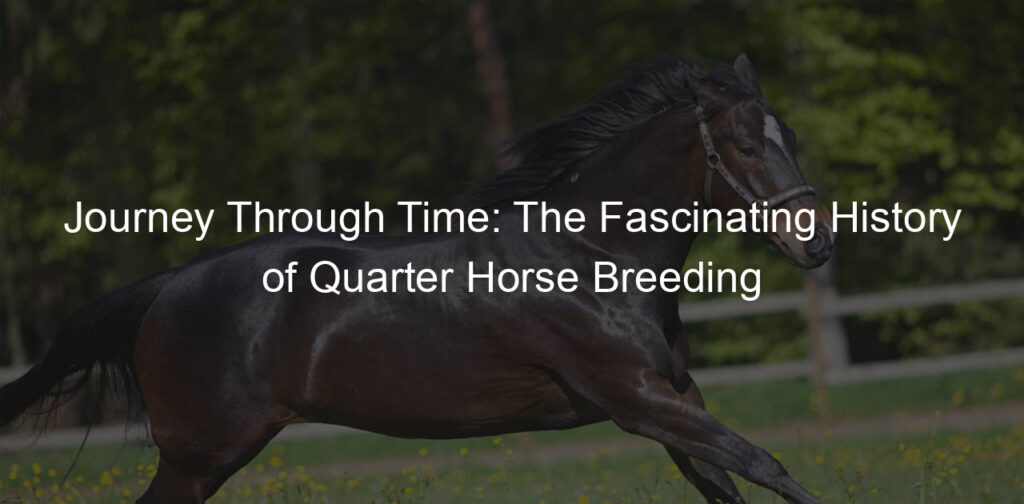Introduction to Quarter Horse History
Hey there, horse lovers! Today, we’re going to take a journey back in time to discover the fascinating history of the Quarter Horse breed. So, saddle up and let’s get started!
- Origins of the Quarter Horse breed
- Significance of the Quarter Horse in American history
The Quarter Horse breed has a rich and colorful history. It all started back in the 1600s, when English colonists in Virginia began breeding imported English Thoroughbreds with native American horses. The result? A new breed known for its incredible speed over short distances. In fact, the Quarter Horse got its name because it could outrun other horse breeds in races of a quarter mile or less. Cool, right? You can learn more about this on Wikipedia.
Now, you might be wondering, “What’s so special about the Quarter Horse in American history?” Well, the Quarter Horse played a huge role in the expansion of the American West. These horses were the preferred choice of cowboys for cattle work because of their quickness, agility, and ability to make sharp turns. They were not just horses; they were trusted partners in building the America we know today. So, the next time you see a Quarter Horse, remember, you’re looking at a piece of American history!
So, that’s a quick introduction to the history of the Quarter Horse. But there’s so much more to learn about this amazing breed. Stay tuned for more exciting horse facts and stories!
Evolution of Quarter Horse Breeding Techniques
Let’s take a journey back in time and explore how the breeding techniques of the Quarter Horse have evolved over the years. We’ll start with the early methods and see how technology has changed the game!
Early Breeding Techniques
In the early days, breeding Quarter Horses was a lot different than it is today. Let’s dive into the details.
- Early American Quarter Horse breeding methods
- Impact of technology on horse breeding
Back in the day, breeding Quarter Horses was all about natural selection and survival of the fittest. Breeders would let the horses roam free in large pastures, and nature would take its course. The strongest and fastest horses would naturally breed and produce offspring, leading to a breed known for its speed and endurance. This method, while simple, was effective in creating a strong and resilient breed.
As time went on, technology started to play a bigger role in horse breeding. Breeders began to use tools and techniques to help them select the best horses for breeding. For example, they started to use pedigree charts to track the lineage of horses and select those with the best genes for breeding. This allowed breeders to make more informed decisions and produce higher quality horses.
These early techniques laid the foundation for the modern breeding methods we see today. They helped shape the Quarter Horse into the incredible breed it is now, known for its speed, strength, and versatility. Stay tuned for more on modern breeding techniques and how they’ve further improved the Quarter Horse breed!
Modern Breeding Techniques
Hey there, horse lovers! Let’s gallop into the world of modern breeding techniques for Quarter Horses. These techniques have changed the game, making it easier to breed healthier and stronger horses. So, saddle up and let’s get started!
- Advancements in Genetic Testing
Genetic testing has come a long way. It’s like a crystal ball that lets breeders peek into a horse’s future health and performance. Isn’t that cool?
Genetic testing helps breeders identify the best horses for breeding. They can find out if a horse has any genetic diseases that could be passed on to its foals. This way, breeders can prevent these diseases and ensure that the foals are healthy.
For example, a common genetic disease in Quarter Horses is Hyperkalemic Periodic Paralysis (HYPP). This disease can cause muscle weakness and even paralysis. But thanks to genetic testing, breeders can now identify horses with HYPP and prevent the disease from spreading to the next generation.
- Role of Artificial Insemination in Quarter Horse Breeding
Artificial insemination is another modern technique that has revolutionized Quarter Horse breeding. It’s like a special delivery service for horse babies!
With artificial insemination, breeders can collect sperm from a stallion and deliver it directly to a mare. This means that the stallion and mare don’t have to be in the same place. So, a breeder in New York can breed a mare with a stallion from Texas. How cool is that?
Artificial insemination also allows breeders to use sperm from stallions that have passed away. This way, they can continue the legacy of these amazing horses.
For instance, the legendary Quarter Horse Impressive fathered many foals through artificial insemination, even after his death. His genes continue to contribute to the Quarter Horse breed, thanks to this amazing technique.
That’s all for now, folks! Stay tuned for more exciting horse facts and stories. Happy riding!
Characteristics of the Quarter Horse Breed
Let’s talk about the Quarter Horse breed. These horses are super cool, and they have some unique features that make them stand out. We’ll look at their physical characteristics, their temperamental traits, and their performance abilities.
- Physical characteristics
- Temperamental traits
- Performance abilities
Quarter Horses are known for their muscular bodies and short, thick necks. They usually stand between 14 and 16 hands high (that’s horse talk for about 4.5 to 5.5 feet tall at the shoulder). Their heads are finely chiseled with a broad forehead and alert, intelligent eyes. Their coat colors can vary, but common ones include chestnut, bay, black, and grey. Wikipedia has some great pictures if you want to see for yourself!
Quarter Horses are known for their calm and steady nature. They are easy to train and are often described as “people-oriented.” They love being around humans and are known for their loyalty and willingness to please. But don’t let their calm demeanor fool you, these horses are also very alert and quick to react when they need to be.
When it comes to performance, Quarter Horses are top-notch. They are known for their speed, especially over short distances. In fact, they got their name because they can outpace other horse breeds in races of a quarter mile or less. They’re also great at tasks that require agility and quick turns, like barrel racing or cutting cattle. Plus, they’re sturdy and strong, making them perfect for work on farms and ranches.
So, there you have it! The Quarter Horse is a breed with a strong, muscular body, a calm and friendly temperament, and impressive performance abilities. Whether you’re looking for a horse for work, play, or just a loyal companion, the Quarter Horse could be the perfect fit for you!
Famous Quarter Horse Breeders and Their Contributions
Let’s take a journey through time and meet some of the most famous Quarter Horse breeders. These are the folks who have made a big impact on the Quarter Horse lineage. They’ve helped shape the breed into what it is today.
- Notable breeders in the history of the Quarter Horse
- King Ranch: Located in Texas, King Ranch is one of the oldest and most famous Quarter Horse breeding ranches in the world. They’ve been breeding Quarter Horses since the 1800s! Learn more about King Ranch here.
- Wagon Wheel Ranch: This ranch in Texas has been breeding Quarter Horses for over 100 years. They’re known for their horses’ speed and agility. Find out more about Wagon Wheel Ranch here.
- Four Sixes Ranch: Another Texas ranch, Four Sixes Ranch has been breeding Quarter Horses since 1900. They’ve produced many champion horses over the years. Check out Four Sixes Ranch here.
- Impact of these breeders on the Quarter Horse lineage
There are many breeders who have made significant contributions to the Quarter Horse breed. Let’s take a look at a few of them:
These breeders have had a huge impact on the Quarter Horse lineage. They’ve helped develop the breed’s unique characteristics, like its speed, agility, and versatility.
For example, King Ranch has been instrumental in developing the Quarter Horse’s speed. They’ve bred many fast horses over the years, which has helped the breed become known for its speed.
Wagon Wheel Ranch, on the other hand, has focused on agility. Their horses are known for their ability to quickly change direction, which is a key characteristic of the Quarter Horse.
And Four Sixes Ranch has contributed to the breed’s versatility. They’ve bred horses that are not only fast and agile, but also strong and durable. This has helped the Quarter Horse become a versatile breed that can excel in a variety of activities, from racing to ranch work.
These breeders have played a big role in shaping the Quarter Horse breed. Their contributions have helped make the Quarter Horse one of the most popular and beloved horse breeds in the world.
Understanding Quarter Horse Genetics
Hey there, horse lovers! Today, we’re going to dive into the fascinating world of Quarter Horse genetics. Ready to gallop into the science behind these amazing creatures? Let’s go!
Genetic Traits of the Quarter Horse
Every Quarter Horse is unique, but they do share some common genetic traits. Let’s explore!
- Common genetic traits in the Quarter Horse breed
- How these traits are passed down through generations
Quarter Horses are known for their muscular build, compact body, and speedy sprinting ability. They have a broad chest, powerful hindquarters, and a small, refined head with a straight profile. Their coat colors can range from sorrel (the most common), bay, black, brown, buckskin, palomino, gray, dun, red dun, grullo, red roan, blue roan, bay roan, perlino, cremello, and white. These traits are all part of their genetic makeup!
Genes are like tiny instruction manuals that tell a horse’s body how to grow and function. When Quarter Horses have babies, they pass these genes on to their offspring. This is why a baby Quarter Horse (or foal) often looks and acts a lot like its parents. But remember, genes can be tricky! Sometimes, a foal might have traits that seem to come out of nowhere. That’s because some traits can skip a generation or two before popping up again.
So, the next time you see a Quarter Horse, take a moment to appreciate the complex genetics that make it so special. And remember, every horse is more than the sum of its genes – it’s a living, breathing creature with its own personality and spirit. Stay tuned for our next post where we’ll talk about genetic disorders in Quarter Horses and what breeders do to prevent them. Happy horsing around!
Genetic Disorders in Quarter Horses
Just like humans, horses can also suffer from genetic disorders. These are health problems that are passed down from parents to their offspring. In Quarter Horses, there are a few common genetic disorders that we should be aware of.
- Common genetic disorders in the breed
- Hyperkalemic Periodic Paralysis (HYPP): This is a muscular disorder that causes episodes of muscle twitching and profound muscle weakness. It’s caused by a mutation in a gene that controls muscle cell activity. Learn more about HYPP here.
- Hereditary Equine Regional Dermal Asthenia (HERDA): This is a skin disorder that causes the skin to be overly stretchy and fragile. It’s caused by a mutation in a gene that’s responsible for producing collagen, a protein that gives skin its strength and elasticity. Learn more about HERDA here.
- Polysaccharide Storage Myopathy (PSSM): This is a metabolic disorder that affects the way a horse’s body stores and uses sugar. It can cause muscle stiffness, weakness, and even collapse. Learn more about PSSM here.
- Steps breeders take to prevent these disorders
- Genetic Testing: Before breeding, horses are tested for these disorders. This helps breeders make informed decisions about which horses to breed together.
- Responsible Breeding: Breeders avoid mating two horses that carry the same genetic disorder. This reduces the chance of producing offspring with the disorder.
- Education: Breeders stay up-to-date with the latest research and information about genetic disorders. This helps them make the best decisions for their horses and the breed as a whole.
Let’s take a look at some of the most common genetic disorders found in Quarter Horses:
Breeders play a crucial role in preventing the spread of these genetic disorders. Here’s how they do it:
Overview of American Quarter Horse Breeding Programs
Hey there, horse lovers! Today, we’re going to dive into the exciting world of American Quarter Horse breeding programs. These programs play a crucial role in preserving the unique characteristics of this beloved breed and shaping its lineage. So, let’s saddle up and get started!
- Role of breeding programs in maintaining the breed’s characteristics
- Impact of these programs on the Quarter Horse lineage
Ever wondered why Quarter Horses are so awesome? Well, a big part of that is thanks to breeding programs. These programs ensure that the best traits of the breed – like their speed, agility, and friendly nature – are passed down from generation to generation. Breeders select the finest horses to parent the next generation, making sure that the Quarter Horse remains as amazing as ever.
These breeding programs don’t just maintain the breed’s characteristics – they also shape the Quarter Horse lineage. By choosing which horses to breed, breeders can influence the future of the breed. For example, if a breeder wants to produce Quarter Horses with exceptional speed, they might choose parents who are known for their fast running. This way, the breeder can help create a lineage of super speedy Quarter Horses!
So, there you have it, folks! Breeding programs are like the secret sauce that makes Quarter Horses so special. They help maintain the breed’s awesome characteristics and shape its lineage. And that’s why we love them!
Stay tuned for more horse-tastic info in our next post, where we’ll compare Quarter Horses to other horse breeds. Until then, happy riding!
Comparing Quarter Horses to Other Horse Breeds
Hey there, horse lovers! Today, we’re going to take a fun journey into the world of horses. But not just any horses, we’re going to compare our favorite breed, the Quarter Horse, to other popular horse breeds. So, saddle up and let’s get started!
History of Horse Breeds
Before we dive into the comparison, let’s take a quick trot through the history of horse breeds. It’s like a time machine ride, but with horses!
- Overview of the history of various horse breeds: Horses have been our buddies for about 6,000 years. They’ve been used for work, transportation, and even war. Over time, different breeds have been developed to suit different needs. For example, the Arabian horse is known for its endurance and speed, while the Shire horse is a big, strong breed used for heavy work.
- Comparison of Quarter Horses to other breeds: Now, let’s talk about our star, the Quarter Horse. This breed is known for its speed over short distances, hence the name “Quarter” Horse. They’re also super versatile and can do just about anything from racing to ranch work. Compared to other breeds, Quarter Horses are generally more muscular and compact, which gives them their unique strength and speed.
So, there you have it, folks! A quick comparison of Quarter Horses to other breeds. Remember, every horse breed is special in its own way. But for us, the Quarter Horse will always be a star!
Conclusion: The Future of Quarter Horse Breeding
As we gallop towards the future, Quarter Horse breeding is set to experience exciting changes. Let’s take a glimpse into what the future might hold for this beloved breed.
- Predictions for future breeding techniques
- How the Quarter Horse breed may evolve
With the rapid advancements in technology, the future of Quarter Horse breeding is likely to be influenced by scientific breakthroughs. DNA sequencing and genetic engineering might play a significant role in shaping the breed’s future. Breeders may be able to select specific traits, ensuring the health and vitality of the horses. Genetic engineering could also help eliminate genetic diseases, leading to stronger, healthier Quarter Horses.
The Quarter Horse breed has always been known for its speed and agility. In the future, we might see these traits further enhanced. With the help of advanced breeding techniques, breeders might be able to produce Quarter Horses that are faster and more agile than ever before.
Moreover, as the climate changes, the breed might adapt to new environments. This could lead to the development of new traits and characteristics, making the Quarter Horse even more versatile and resilient.
In conclusion, the future of Quarter Horse breeding is bright and full of potential. With the help of science and technology, we can look forward to a new era of healthier, stronger, and more adaptable Quarter Horses. So, let’s saddle up and ride into the future together!









